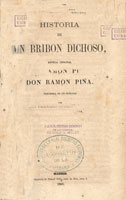2.3.5.4 The novelistic production of Ramón Piña (1819 – 1861)

Ramón Piña published two novels in Madrid, titled “Geronimo the Honorable” in 1859 and “History of a Happy Scoundrel” in 1863. He is also credited with “Doctor Lañuela” from 1860; however, his authorship of the latter has not been confirmed. He translated several works into Spanish, along with original works in English and French, and contributed to several publications, such as “Revista de la Habana.”
“Geronimo the Honest” has a clear legacy of the Spanish picaresque, both in its ironic sense and in terms of the vocabulary and grammatical turns of phrase typical of Castilian Spanish. In this and in the adventurous conception of its main character, whose name is indicated in the title, the influence of Don Quixote can be seen. This character also has a clear characterological similarity with Voltaire’s Candide.
The author introduces a questioning of the axiological matrix of the time through the naivety of his character, who had placed justice and human rationality on a much higher plane than what was in reality, although Geronimo is compelled to progressively grasp the contradictions and injustice that prevailed in society, this does not transform the generous essence of his temperament, although he acquires a certain sarcasm and a tendency to evade social interaction.
This first novel served in a way as a framework for “Historia de un rascal feliz” (Story of a Happy Scoundrel), which establishes a parallel between ethical behavior and opportunistic conduct, in this case typified by the classic scoundrel associated with the world of law, who uses legal tricks to his advantage.
The novel presents discontinuities and parallel lines that lend greater depth to its reading. As for rhetorical figures, it makes extensive use of paradox and ironic elements to express the movements of Eustaquio Barullo’s character within the elites of Havana society. It touches on the subject of slavery in passing, but without adopting a definitive abolitionist position, as it shared the fear of Black people that prevailed in society at the time.
In both works, the search for truth is present in an intricate web of interests and double standards. His character, Geronimo, claims to seek a country where there is only one truth, and where it always shines forth. In “Historia de un rascal felizo,” the author even refers to a “legal truth” in the sense of a falsified one. These works constitute a firm fictionalization of the intricacies of Cuban colonial society.








